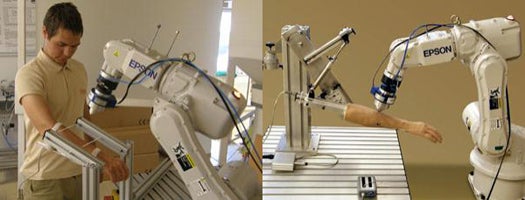Slovenian Robot Punches Humans in the Arm, to Test Pain Thresholds (Supposedly)
A robot in Slovenia is bringing the pain in name of science, repeatedly punching human research subjects in an effort...

A robot in Slovenia is bringing the pain in name of science, repeatedly punching human research subjects in an effort to see just how much of a beating they can take. As New Scientist points out, this is a stark violation of Asimov’s first law of robotics, but the scientists behind the study say the point of the study is to better define that rule. After all, how can a robot be expected not to adhere to the law (“a robot may not injure a human being”) if it doesn’t first know the boundary between harmful and harmless?
Using a powerful Japanese-built industrial robot, researchers at the University of Ljubljana are conducting the study on their own arms. Using two different tools – one blunt and one sharper – the robot struck each participant a total of 18 times at different impact energies. The subjects were then asked to rank the degree of pain on a scale ranging from “painless” to “unbearable.”
By doing so, the researchers hope to arm future robots with a sense of what kinds of motions and impacts cause varying degrees of human pain. As robots become more uniquitous, it’s inevitable that they’ll be interacting with human more often and in closer quarters. The robot in the study was actually programmed to move toward a certain point in space beyond the human arm, pushing the arm aside as it moved, the idea being that a robot and human working in close proximity will eventually come into contact and the robot needs to be aware of its own strength and the human’s tolerance for it so no one meets a mechanically violent end.
Most of the subjects described the robots jabs as mildly to moderately painful, so it seems the robot is playing nicely enough. And while it might seem silly or even simplistic to sink research dollars on a people-punching robot, the field of human-robot interaction is actually quite challenging. Israeli researchers are offering a cash prize for the best robotic hand capable of performing a handshake, a task that sounds simple but in reality is seriously complex. If we’re going to live side-by-side with our future robot companions, we’ll first have to teach them how to be a little more like us.